How to build a reliable carport with your own hands: step-by-step instructions
There is nothing unusual about storing a car outdoors.Many craftsmen believe that open storage helps to better preserve the body if you have a private home. Therefore, many avid motorists make a carport even for their dacha.
The content of the article:
Choosing the size of the future canopy
Typically, dimensions are planned based on the capabilities of the local area. Therefore, before making a carport, you need to consider all layout options.
There is not much free space for a future carport. Moreover, it is not recommended to do it next to the house - the car will get in the way. Therefore, the canopy is either built right outside the entrance gate, or you will have to sacrifice flower beds and beds.
Optimal dimensions for building a carport:
- For a passenger car - 4x6 m or 4x5.5 m. As a rule, a meter is added to the dimensions of the car on the sides, front and trunk.
- For a car with a trailer - 4x8 m, if with a trailer - 12x4 m.
- If the canopy is needed for a bus or a truck, then the size is increased to 4.5x7 m.
The design of the canopy must ensure the free opening of the car doors, while the driver and passengers must not go beyond the hard surface of the site. This must be taken into account if you make a canopy in the form of a canopy attached to the wall of the house.
The height of the canopy depends on the type of machine.For a passenger car, 2.5 m is enough. An air gap of 1-1.2 m should be left between the ceiling and the roof of the car. If the structure is closed on at least two sides by the walls of the house, a gazebo, or a summer kitchen, then the roof should be made higher - not less than 3.5 m.
A selection for you:
- DIY 3 by 3 gazebo
- How to make a 3 by 4 gazebo with your own hands
- DIY gazebos made of wood
- DIY brick gazebo
- How to build a comfortable metal gazebo with your own hands
- We build a gazebo from polycarbonate with our own hands
- How to make a gazebo from a profile pipe with your own hands
- We make a gazebo from scrap materials with our own hands
- We build a modern gazebo with a barbecue for the dacha with our own hands
- How to make a beautiful gazebo from pallets
- Do-it-yourself gazebo with a pitched roof
- DIY hexagonal gazebo
Selecting materials and selecting tools
The canopy is made mainly from profiled pipes of different sections. For vertical supports, a corrugated pipe with a cross-section from 70x70 mm to 90x90 mm is selected, for the roof frame - 50x50 mm and 50x25 mm.
The racks are often made from a two-inch water pipe, and the frame for the roof can be made in the form of a composite beam of 2 bent arches, with a cross-section of 20x50 mm.
The sheathing for the roof is made of wood, usually an inch edged board, or thin profiled pipes 20x40 mm are used. It all depends on the type of roofing.
The tools you will need are:
- grinder with cutting discs for metal;
- concrete mixer;
- shovel, wheelbarrow;
- electric drill, screwdriver with a set of drills, a cross bit and a hex head;
- welding inverter;
- fasteners (screws).
For painting, you will need to prepare a primer with a rust converter and enamel for exterior use.This must be done in advance, before construction. In addition, you need to choose the material for the roofing of the canopy, and also decide how exactly to make a platform for the car.
Making the foundation
There are 3 foundation options. The first is to make supports for the canopy separately from the foundation of the site. In this case, each pillar is concreted separately from the others, in its own hole. It has to be made deep enough to avoid the supports bending under the influence of wind. This method is used mainly for canopies and canopies with a flat pitched roof.
If you make a canopy on a dirt plot, for example, in a country house, then such a foundation is best suited due to the low labor intensity of production, as well as simple concreting technology.
The second option is to pour the supports along with the concrete screed of the site, as in a garage. The depth of embedding of pipes is much less, the base is rigid. Such a foundation is made for high canopies with gable, asymmetrical or arched roofs.
The third option is a connected foundation. Vertical posts are installed in holes, between which a trench is dug with formwork for concreting or brickwork. At the bottom, metal supports are tied with horizontal jumpers made of 50x50 mm corrugated pipe. The pipes are poured with concrete or laid with bricks at the level of the site.
Lay out the frame
Sheds with a flat pitched roof are made according to the general scheme. After installing the supports, weld the top trim and horizontal crossbars for attaching the wooden sheathing under the roofing.
Gable roofs are usually assembled from ready-made triangles welded in a workshop. It is easier to make a rafter pair on the ground than to cut it and adjust it to size directly on the roof.
Many car owners make complex arched roofs, often without horizontal bracing. The base for the roofing is bent on a pipe bending machine. Most often they are made from a single profile 70x40 mm.
The design turns out beautiful, especially if the roof is made translucent, for example, from cellular polycarbonate. In addition, the arc makes it possible to reduce the height of the canopy, and at the same time the air gap above the machine.
But this scheme has one important drawback - an arch made of a single pipe without a horizontal cross member exerts additional spreading (horizontal) pressure on the supports. The more snow there is in winter, the higher the risk of the carport roof falling on the car. The design is beautiful, but it must be done with additional struts and spacers.
How to lay out the site
For a carport, it is important to choose the right platform material. Most often, car owners leave the issue of arranging the coating for the near future. At best, they plan the site. It is enough that the car is under the protection of the roof.
But the right covering for the site is not only about protecting the running machine. This is also the drainage of rainwater or the fight against dirt on the site.
Gravel
The simplest solution is to cover the area under the car with crushed stone or gravel. This is usually done in suburban areas and dachas. The gravel cushion only protects the car from wet ground. You will still need to do drainage and water removal.
Before filling with gravel, you need to plan and lay drainage gutters. Usually on the sides, on the back side of the canopy. The base under the gravel cushion is covered with sand and clay and compacted.About once a year, additional gravel leveling needs to be done under the canopy to get rid of the machine-rolled ruts.
Paving slabs
Ideal for a carport. But at the same time the most expensive. Therefore, it is necessary to lay the tiles simultaneously with the improvement of the entire local area. To lay it, you need to remove the soil to a depth of 20 cm, make a cushion and water drainage.
Under a canopy, paving slabs last longer than on paths or near the house. The main enemy is moisture and frost, so it is necessary to make a drain for melt and rain water.
Concrete
The platform for the car can be filled with a concrete screed. For a 4x5 m canopy you will need at least a cube of concrete. Plus - you need to reinforce it with fiberglass reinforcement. Concrete is convenient in that you can immediately drain water, form gutters and drain water coming from the overhangs of the canopy.
The top layer of concrete must be treated with waterproof impregnation, and it is also advisable to make a corrugated knurling of the surface. In winter, you can easily fall on concrete - the canopy blocks sunlight, so meltwater freezes faster than it is blown away by the wind.
Types of roofing
The safety of the car’s paintwork depends on how well the roofing material is chosen. If you build a completely metal, opaque roof, then the water on the site will be reluctant to leave, only due to a draft in the yard.
If you make a transparent roof for the canopy, then moisture and snow will disappear faster. But the car body, even under a protective canopy, will begin to heat up more.
Awning
A good option for hot climates. The roofing frame of the canopy is made with lacing and frequent sheathing of thin wooden slats.A tent roof for a canopy is valuable on 3 points:
- The fabric awning “breathes” and does not heat up to high temperatures.
- Most protective awnings for canopies are light in color, which means they reflect the sun's rays well.
- It is possible to organize additional protection of the machine from ultraviolet radiation and heat.
It is enough to pour water on the tented roof, and it will be cool under the canopy all day.
There is no point in using awning awnings in rainy or snowy climates. The fabric strongly absorbs moisture, drips onto the car, and in winter can tear from wind and snow.
Polycarbonate
A universal type of roofing covering. Monolithic polycarbonate is expensive and transmits up to 99% of sunlight. Monolithic sheets can be used for roofing only if the canopy on the sunny side is at least partially protected by trees or a building.
Cellular polycarbonate can be used to make a roof on any canopy with an arched or flat roof. As a rule, the material scatters light well and is often painted in soft shades of green, red, and yellow.
The peculiarity of polycarbonate roofing is its low strength. It does not withstand hail impacts, and also quickly becomes covered with cracks if it is laid without a protective film.
Corrugated sheet
Typical material for roofing utility rooms. Corrugated sheeting is widely used for fencing areas; roofs and frame buildings are made from it. The main advantage is that it can be easily mounted on any roof structure except an arched one.
Flaws:
- High windage. If the roofing is done incorrectly, the sheets are often torn off by strong winds, which can damage the car.
- Insufficient strength, you need to make a reinforced sheathing, otherwise a thick layer of snow will push through the roof joint, and the car will be flooded with melt water.
The owner can install a roof made of corrugated sheets on a canopy himself, on his own, without any problems. It makes sense to make a roof from corrugated sheets, since in terms of price this is one of the most affordable covering options.
Metal tiles
The coating is widely used for the roofs of residential buildings, cottages, gazebos, and saunas. Thanks to the stamped profile, which imitates the relief of tiled masonry, the metal tile sheet has higher rigidity. It is practically not afraid of gusts of wind. Therefore, roofing on awnings and canopies is often done without boarding.
Flaws:
- High price.
- Difficulty in cutting, you need to use a special tool.
- You can make roofs with a slope angle of only more than 20O.
It makes sense to use metal tiles as a roofing covering only for sheds attached to the house, and if the building itself has a roof of the same color and texture.
Carport Installation Instructions
Before starting work, you need to check the clearance dimensions. Simply put, will the car be able to drive under the conditional canopy without unnecessary hassle, taking into account the location of the pillars? It is clear that the canopy is being built without a fence, but in winter there may be snow and even snowdrifts.
Preparatory work and measurements
The canopy will be 4x5.5 m in size, with an average height of 250 cm. This is the roof dimension; the markings for the pits will need to be reduced by 20 cm on each side of the rectangle.
For marking, 4 pegs are driven into the ground at a distance of 4 m and 5.5 m from each other. Next, pull the cords around the perimeter.The thread is not tied, but simply wrapped around the head of the peg so that you can change the position without untying the cord.
The next step is to align the contour. The difference in the lengths of the diagonals should be no more than 5 mm. Holes for supports can be dug with a shovel or made with a garden drill. Depth – up to 70 cm, no less. A layer of sand and clay (5 cm) is poured onto the bottom and compacted thoroughly. Next, a plastic film is laid, on top of which fine crushed stone (5 cm) is poured.
Installing carport supports
Vertical posts for the canopy are cut in advance. When purchasing at the warehouse, you can ask to cut the square pipe (80x80 mm) into 3 m pieces. This makes it easier to transport in a car. The height of the supports on the left is 250 cm, on the right - 240 cm, 50 and 60 cm, respectively, will go into the concrete of the foundation.
Each support must be installed in a hole on crushed stone and immediately leveled vertically. There is no need to drive broken bricks into the hole; it is better to support it with several pieces of slabs or scraps of boards.
Once all 4 supports are level, freshly prepared concrete is poured into the hole. It must be fluid. You need to wait about 3 more days until the concrete sets and settles.
Strapping and strengthening the frame
The heads of the supports must be tied with a square corrugated pipe 50x50 mm. Two 5 m sections are immediately welded to the tops of the supports. A small error will not in any way affect the stability of the canopy and the protection of the car even in heavy snowfall or gusty winds.
You need to immediately clean and paint over the welds, without waiting for it to rain or for condensation to form on the metal.
The next step is to install the steel cross members. For the roof of the canopy, you can use the same square 50x50 mm or a truncated version 50x25 mm.
To form the slope of the canopy, you will need seven blanks of 4 m each. You will have to order enough metal from the warehouse. It’s better not to carry such a long profile in your car.
Laying a roof for a canopy
Next you need to sew on the sheathing of boards. Since the car is planned to be protected from rain and birds using corrugated sheeting, it is better to use a 150x25 mm spruce board. You will need 40 m. of the whole board. Again, it is better not to cut, but to buy in solid pieces of 6 m each. In this case, the material can be delivered by your own car.
Sheets of corrugated sheets measuring 1.18 x 4 m are laid with an overlap perpendicular to the entrance of the car. The size of the profiled sheet is chosen so that the roof can be laid with your own hands, without helpers.
If protection for a car is being built on a site with dense buildings of neighboring houses, then you can get by with a simplified sheathing, as in this case. If you plan to build a shed in a country house or in an open area with strong winds, then the sheathing should be made entirely of boards or slabs.
The roof has an unusual shape. Instead of the classic version with a slope from the facade to the rear, we got a flat slope to the side. This was done intentionally, as it is possible to drain rainwater through a gutter to the “wild” side of the site, rather than onto a concrete path. The project plans to install a barrel to collect rainwater.
Coverage option
As practice shows, an asphalt surface with pressed limestone chips is best suited for storing a car. You can make the site yourself or negotiate with road workers. You can roll the area with asphalt mixture, fill it and compact it in an hour in good weather.
If you make a covering from tiles, the price will triple; a concrete screed costs about 40% less than a tiled one.
Most craftsmen prefer to make yard buildings with their own hands. This is not difficult, but you need to remember that if you make a carport with your own hands, with a foundation and walls sealed (from the wind), then such a structure can be qualified as capital, which means you need to enter data about it in the home ownership passport.
Tell us about your experience in building canopy canopies - which design can be considered the most successful? Save this article to your bookmarks bar so that useful tips from it are always available to you.
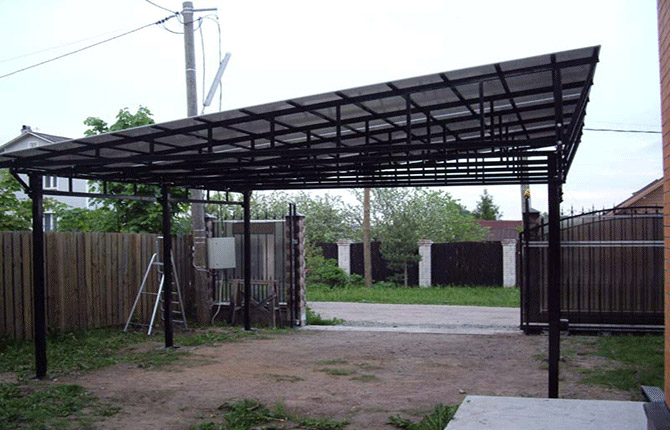




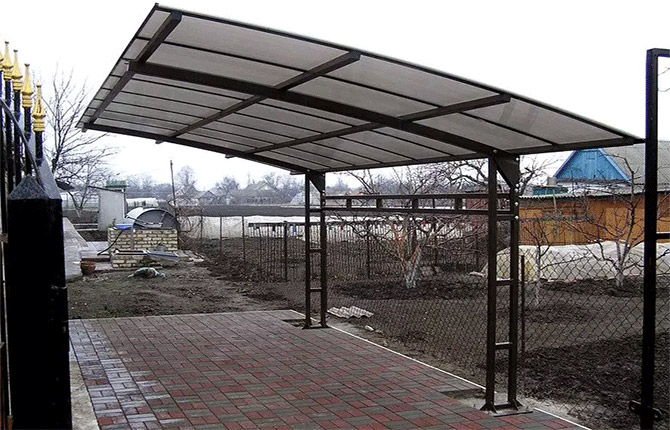
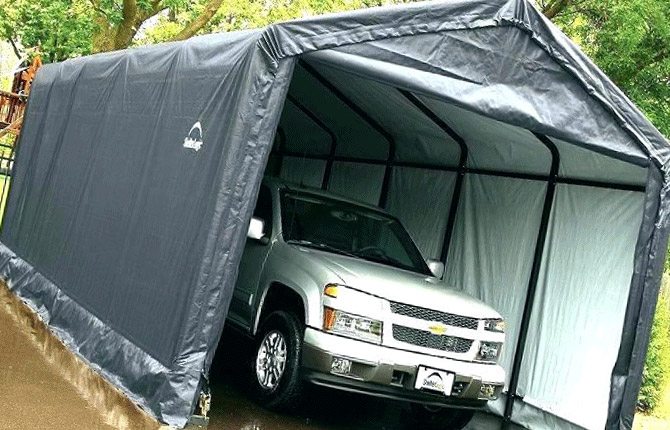
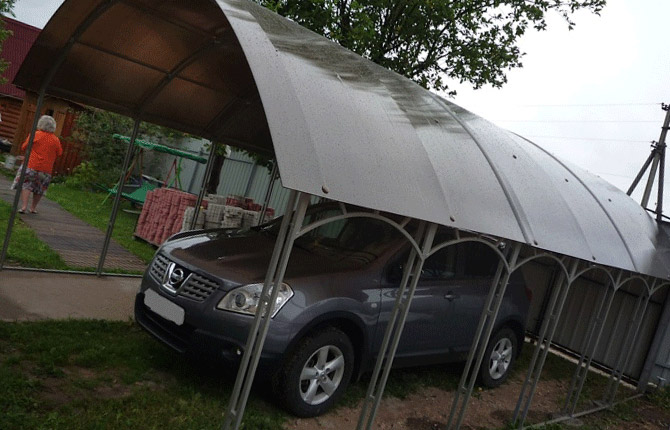

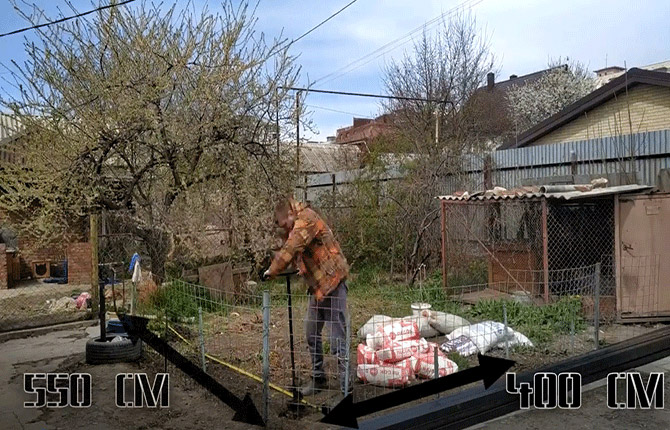
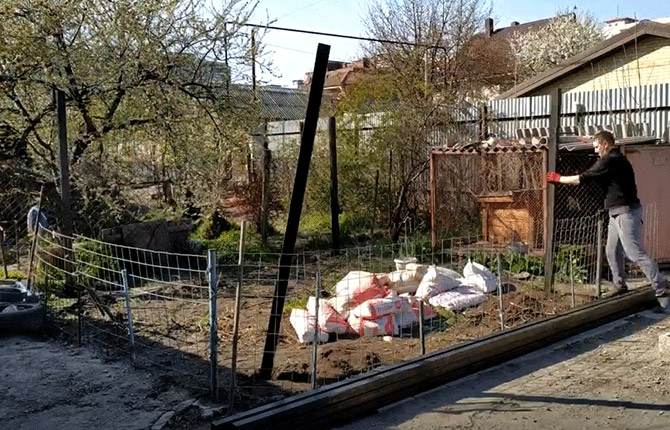




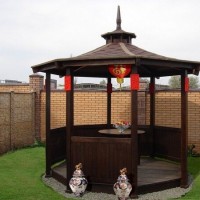
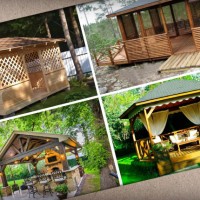
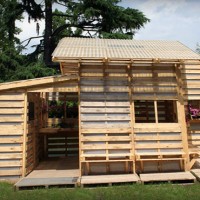

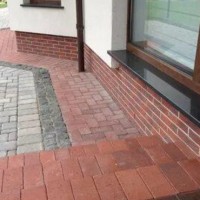
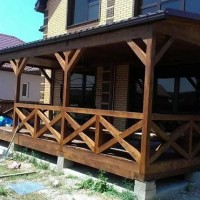




The canopy should be done correctly on steel poles, in an archless manner. Arches are a problem with water flowing over the roof. YES it’s beautiful, but who needs beauty at the dacha for a double price tag. That's why the roof is flat. The platform is tile, if at your home, if at the dacha, then paved with limestone or shell rock.
Make the sheathing straight away, you can’t go wrong, if the corrugated sheeting is not torn off by the wind, slate is in no case, you will damage the car.